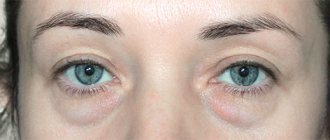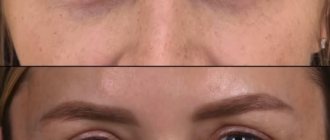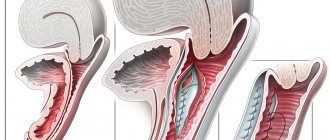Indications for intimate plastic surgery.
A number of factors may be the reason for prescribing intimate plastic surgery:
Unpleasant sensations during sexual intercourse;
Discomfort when wearing underwear;
Inconveniences that arise when performing physical exercises;
Dissatisfaction with the appearance of the labia; they do not look aesthetically pleasing and require correction.
During the operation, all of the above deficiencies are corrected. After undergoing intimate plastic surgery, women feel desired and more confident. They are no longer ashamed of their body, which means the quality of sexual relationships noticeably improves.
Medical indications for intimate plastic surgery:
With enlarged labia minora, when the labia minora protrude significantly beyond the labia majora;
Asymmetry of the labia minora may be a consequence of childbirth or a congenital anomaly;
The labia are wrinkled, flabby, stretched or depigmented;
Restoring the natural shape, elasticity and patency of the vagina after childbirth
Decreased sexual pleasure and desire;
Age-related loss of tissue elasticity and deformation;
Chronic urinary incontinence or urinary incontinence after childbirth;
Lack of orgasms.
Before the operation, it is necessary to undergo a consultation with a surgeon; he will explain all the nuances of intimate plastic surgery. In addition to the consultation, it is necessary to undergo a number of preliminary examinations. Any surgical intervention has risks, but with intimate plastic surgery they are reduced to almost zero.
Labiaplasty of the genitals at the time of this operation the size and volume of the labia are adjusted, the doctor eliminates the asymmetry. The operation is performed under local anasthesia and is performed on an outpatient basis.
The procedure takes up to an hour, depending on the intervention technique. Intimate plastic surgery is classified as minimally invasive.
Recovery after intimate plastic surgery does not take much time, and rehabilitation proceeds without complications
Laparoscopic operations in the gynecological clinic of the IGPC
The laparoscopic technique eliminates the need to make large incisions. Instead, the surgeon can view organs from inside the body using a laparoscope, a thin instrument that resembles a telescope.
After introducing carbon dioxide into the abdominal cavity (the abdomen is inflated), the laparoscope is inserted into the patient’s body through a small tube (trocar), with the help of which a puncture of the integumentary tissue is first made.
This requires a skin incision only 1 cm long. A small video camera and a light source are connected to the laparoscope, which allows the image from the video camera to be transmitted to the monitor via a fiber-optic cable.
The surgeon can perform the operation while looking at a monitor screen with an image magnification of 4-10 times.
For laparoscopic operations, special instruments are used, which are inserted along the same trocars through separate punctures.
What are the benefits of laparoscopic surgery?
The large incision typically used in traditional surgery causes significant trauma to the muscle tissue. In this regard, pain occurs after surgery, and the wound healing period takes quite a long time. Small punctures made during endoscopic surgery do not injure muscle tissue.
As a result, patients:
- experience much less pain after surgery, which may eliminate the need for painkillers;
- spend less time in the hospital (usually 1-2 days);
- recover faster, can return to normal activities and go to work faster;
- have no worries about the postoperative scar;
- avoid the formation of adhesions in the abdominal cavity after surgery.
What gynecological operations can be performed laparoscopically at the gynecological clinic of the IGPC?
Today, about 95% of all gynecological operations can be performed laparoscopically. Currently, the gynecological clinic of the IGPC performs operations of various levels of complexity using laparoscopic access.
This:
- Diagnostic laparoscopy is an examination of internal organs with an unclear diagnosis: infertility, chronic pelvic pain (if endometriosis of the uterine appendages or peritoneum is suspected, adhesions in the pelvis, etc.).
- Voluntary surgical sterilization (tubal ligation).
- Removal of ovarian cysts and tumors (in the vast majority of cases, performed laparoscopically).
- Checking and restoring the patency of the fallopian tubes in case of tubal infertility, as a stage of preparation for IVF.
- Emergency laparoscopy can be performed in case of ectopic pregnancy, rupture or torsion of ovarian cysts, or apoplexy (rupture) of the ovary with internal bleeding. In some cases, for purulent-inflammatory diseases of the uterine appendages and pelvic cavities (in the absence of the effect of antibacterial therapy within 24-48 hours), as well as as a differential diagnosis between acute gynecological and surgical pathologies.
- Removal of fibroids (conservative myomectomy), reconstructive surgery for abnormalities of the uterus.
- Removal of the uterus with appendages (hysterectomy) and without appendages: for uterine fibroids; internal adenomyosis; recurrent (repeating) endometrial hyperplasia and polyps, pretumor and initial tumor changes in the uterus and cervix, with recurrent uterine bleeding).
- Removal of the uterus for fibroids (uterine amputation)
Now we are beginning to master laparoscopic sacrovaginopexy - this is a reconstructive operation using synthetic materials aimed at eliminating prolapse of the uterus and vaginal walls.
Are there any contraindications to laparoscopic surgery?
Absolute contraindications for laparoscopy are diseases of the cardiovascular and respiratory systems in the stage of decompensation, shock and coma, cachexia (severe exhaustion), disorders of the blood coagulation system, hernia of the anterior abdominal wall or diaphragm.
Contraindications for elective surgery are:
- acute infectious diseases suffered less than 1 month before surgery;
- deviations in clinical laboratory test results (usually in these cases the patient is referred to a therapist to decide on the possibility of surgery and the need for further examination);
- bronchial asthma with frequent exacerbations;
- hyperotic disease with high blood pressure;
- pronounced adhesive process in the abdominal cavity;
- significant size of the pathological formation of the internal genital organs.
The qualifications of gynecologists at the gynecological clinic of the IGPC allow us to successfully solve completely different problems of women’s health. Someone here will be helped to feel the joy of motherhood by being cured of infertility, and someone will be saved from uterine fibroids or benign tumors. After surgery, patients are kept in a hospital setting under constant 24-hour supervision.
We are glad to be useful to our dear women.
We would like to note that you should contact a doctor not only if you have pain, atypical discharge or other unpleasant symptoms. Every woman should visit a doctor at least 2 times a year for preventive purposes. This will make it possible to identify any pathological process at an early stage, when it does not pose a serious danger to the health and functioning of the reproductive system of the body.
Take care of your health.
Types of intimate plastic surgery
Thread lifting. In simple words, vaginal tightening. With this type of intimate plastic surgery, two equally directed threads are used, which help to instantly tighten the tissue mechanically. After dissolving the threads, a long-term effect is ensured. This type of intimate plastic surgery is performed under local anesthesia; at the woman’s request, general anesthesia can be used. The duration of this procedure is about 60 minutes. As a result, the vagina tightens, which has a positive effect on the quality of sexual contacts. The possibility of genital prolapse is significantly reduced and the risk of bacterial infection is minimized;
Rejuvenation of vaginal tissues. This type of intimate plastic surgery can be divided into two subtypes.
- Laser rejuvenation of vaginal tissue. With this type of intimate plastic surgery, all roughness on the mucous epithelium is removed, the wall is noticeably thickened, the muscles are naturally tightened, and the G-spot area increases. The connective tissue between the vagina and anus is smoothed. With intimate plastic surgery, lasers can be used to correct certain parts of the genital organs.
- Surgical rejuvenation of vaginal tissue. In this case, the problems of frigidity and chronic urinary incontinence are solved.
Each of these two types of intimate plastic surgery takes at least two hours. As a result of the procedure, problems of aesthetics and sensuality are solved. Recovery after the laser rejuvenation method takes only a day, but intimate relationships should be canceled for a month.
Vaginoplasty surgery. This type of correction is intended for women who have given birth and their genitals have changed significantly during childbirth. Women try not to talk about such problems and are very often embarrassed to see a doctor. During childbirth, the intimate muscles are stretched to the limit, and if you remember that the child’s head is at least 10 cm. During childbirth, tissue tears occur; such tears are not always successfully eliminated by gynecologists at maternity hospitals. For doctors delivering babies, the patient’s health is a priority, and the aesthetic aspect remains in the background or outside of attention. As soon as postpartum recovery takes place, it may turn out that sexual intercourse has ceased to bring pleasure, and there are cases when it even causes painful sensations. As a result, the woman becomes withdrawn and develops complexes. Intimate plastic surgery is necessary to strengthen the muscles and muscular frame, tighten the vaginal walls, remove rough and insensitive tissue, and narrow the passage. After intimate plastic surgery, the genitals are given a prenatal appearance. Postpartum injuries, flatulence and urinary incontinence are eliminated.
Hymenoplasty . Surgery to restore the hymen. In the field of intimate plastic surgery, this operation is one of the most popular. Technically, this procedure is relatively simple, but the woman experiences discomfort for quite a long time after the operation. Indications for the procedure are usually the client’s desire or aesthetic beliefs. This operation can be divided into two types.
- The specialist sews the remaining edges of the hymen together.
- The specialist forms a new hymen. This method is used when virginity is planned to be preserved for a long time. This method is called triple hymenoplasty. During this process, a new hymen is formed from tissue in the vestibule of the vagina. For this method, only mucous epithelium is used, so the patient must be absolutely healthy. The operation lasts about an hour. The sutures placed during the process dissolve on their own. This method is considered the most reliable, but it should be remembered that at the time of the first sexual intercourse the bleeding will be very heavy. The operation can be carried out several times, since sooner or later the excess mucous tissue will dry out
Intimate plastic surgery (vaginoplasty) during menopause In such cases, intimate plastic surgery is necessary to correct age-related changes in the genital organs and to rejuvenate the genital organs. Prolapse of the walls of the vagina and uterus often occurs during menopause, and such consequences are also possible after inflammatory processes. It often happens that the problem arises due to changes that were not corrected after childbirth, and this subsequently leads to pain and discomfort. As a result of these changes, a woman loses interest in sexual activity, as she is constantly in a state of stress. Intimate plastic surgery eliminates pain in the genital area and atrophy. Both anterior and posterior colpography are performed, which gives the vagina elasticity and restores its natural shape. After intimate plastic surgery, the sensuality of the intimate area is completely restored.
Vaginal plastic surgery
More and more often, women are asking the question: how can they narrow the vagina without resorting to surgery? SM-Clinic specialists use modern non-surgical methods: contour plastic surgery and thread correction of the vagina.
Vaginal contouring. This procedure is most often sought by patients whose vagina has become stretched after childbirth. As a result, the muscles of the organ lose elasticity, and the woman ceases to receive sexual satisfaction. At SM-Clinic, vaginal rejuvenation is carried out using filler injections based on hyaluronic acid. The procedure is performed with 1-2 degrees of prolapse of the vaginal walls.
Thread lifting of the vagina.
If the vagina has become large after childbirth, but there is no prolapse of its walls, you can use the thread correction procedure. Its essence is the introduction of 3D Lead Fine Lift mesothreads. The threads in the vagina dissolve within 2 years, being replaced by fibrous fibers. As a result, the tissue becomes denser and the vagina narrows, regaining its original volume. Read more >>>
Combined plastic
In some cases, our doctors recommend combined plastic surgery. The combination of the two above methods gives excellent results: tightening the vagina, improving muscle tone and general tissue rejuvenation.
At the request of the patient, our doctors can, simultaneously with vaginal plastic surgery, perform non-surgical correction of other organs of the intimate area: increase the volume of the G-spot, perform clitoral plastic surgery, plastic surgery of the labia majora and minora.
Preparing for the procedure.
Before non-surgical tightening of the vaginal walls, a woman must undergo a smear for microflora and sexually transmitted infections. Injections and thread correction are usually carried out a few days after the end of menstruation to reduce the risk of developing an inflammatory process.
Rehabilitation period.
The main advantage of non-surgical vaginal surgery at SM-Clinic is the minimal recovery period. Immediately after the procedure, the patient can go home. For 5–14 days, you must refrain from sexual intercourse, visiting a sauna or swimming pool, and limit physical and sports activities.
Reducing the vaginal opening using non-surgical plastic surgery is an opportunity to get rid of unpleasant sensations in the shortest possible time and again enjoy a full sex life. As a result, you will get toned and elastic vaginal muscles, and with the introduction of fillers, a more sensitive clitoris and G-spot. The effect of contour or thread correction lasts 1-2 years, after which our experts recommend repeating the procedure.
Contraindications.
Reducing the vaginal opening and tightening the walls using a non-surgical method is not performed during pregnancy and lactation, in the presence of infections and within 6 weeks after childbirth.
Rehabilitation after intimate plastic surgery.
A few hours after the end of the procedure, you will be able to leave our clinic on your own. We use only sutures with self-absorbing thread. Wounds in the intimate area heal quite quickly.
There are very important precautions that women must follow. During the first few days, you should not sit and under no circumstances should you cross your legs.
It is advisable to stop sexual activity for a month after intimate plastic surgery. Do not wear synthetic underwear or tight jeans. You will be able to see the result in about two months, when the swelling subsides completely.









